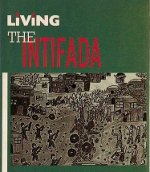
Living the Intifada by Andrew Rigby (London, Zed, 1991) examines the Palestinian intifada as a day-to-day experience with detailed analysis of education, health and the economy under occupation. Writing contemporaneously, Andew Rigby "seeks to bring out what makes the first intifada possible as a form of unarmed resistance involving an entire population".
This out-of-print book is now available as a pdf either by clicking on the chapter headings below or going to the bottom of the page.
Table of Contents for Andrew Rigby, Living the Intifada
- Introduction
- 1. The Organisation of Resistance
- 2. Repression and the Threat to Life and Limb
- 3. Coping with the 'Epidemic of Violence'
- 4. The Struggle over Education
- 5. Economic Aspects of the Intifada
- 7. The Response of the Israeli Peace Movement
- 8. The limitations of the Intifada as a movement of non-cooperation
- Annex: Palestinians in the Israel: the Impact of the Intifada, by Marwan Darweish
The historical background
The peace process
Introduction: the Palestinians as a subject people
The first months: the establishment of the UNC
The Israeli response
Towards an organic state
Introduction
Background: the Iron Fist
The Uprising as unarmed civilian-based resistance
Force, might and beatings
'Non-lethal' methods of repression: gas, rubber and plastic
Deportations
Demolition and collective punishments
Imprisonment and detention
Green cards
'Death squads'
The role of the settlers
The costs of repression
Background
Union of Palestinian Medical Relief Committees
The duality of Palestinian health problems
The Uprising: its consequences for health
Coping with emergency
The normalisation of emergency work
Health care as an instrument of collective punishment
Conclusion
Introduction
Background
The struggle over schooling
The assault on academe
Conclusion
Introduction
The economic background
The early days of nonviolent 'blitzkrieg'
Business and commerce in the Intifada
The tax war
Collective economic punishment
The household economy
External funding
Other external factors
Conclusion
Introduction
Background
The Israeli public relations disaster
Attacks on the 'oxygen of publicity'
Presentations of reality
The significance of language
Satisfying the thirst for news
'Destructive ambiguity'
Conclusion
Introduction: 'the great chain of nonviolence'
Background
The mushrooming of Israeli peace and protest groups
Yesh Gvul
Peace Now
Conclusions
The contradictions of unarmed civilian resistance
The failure of third parties
From civilian resistance to social defence










 esistance.info
esistance.info

